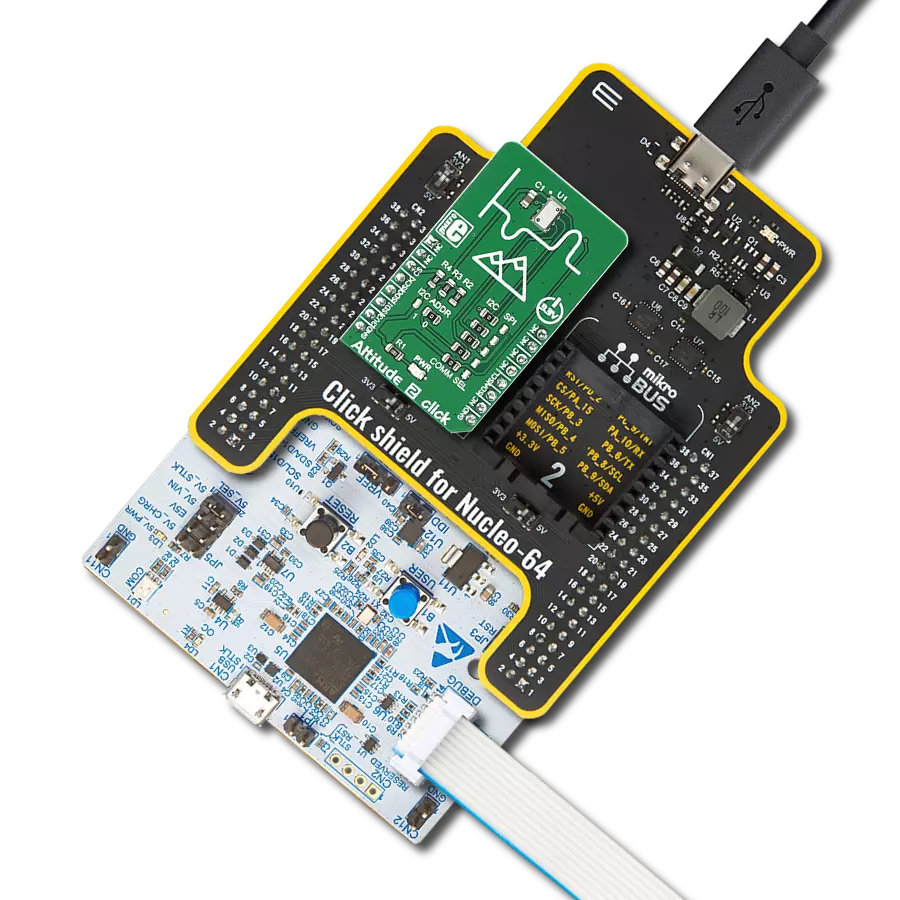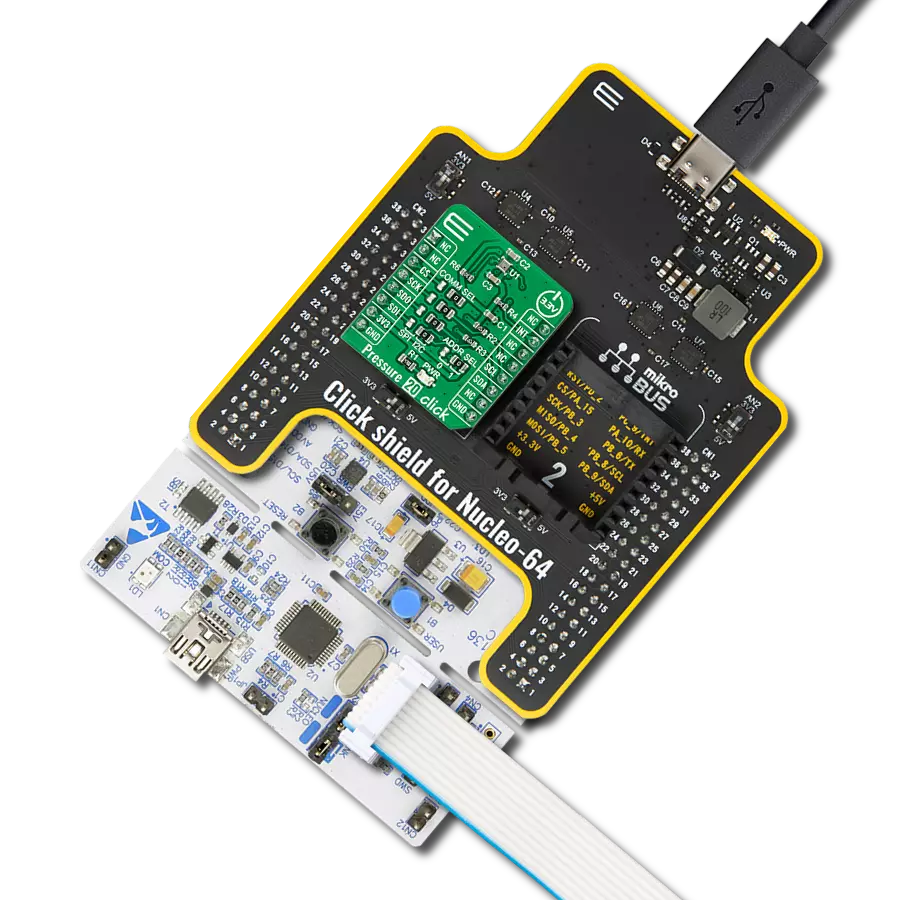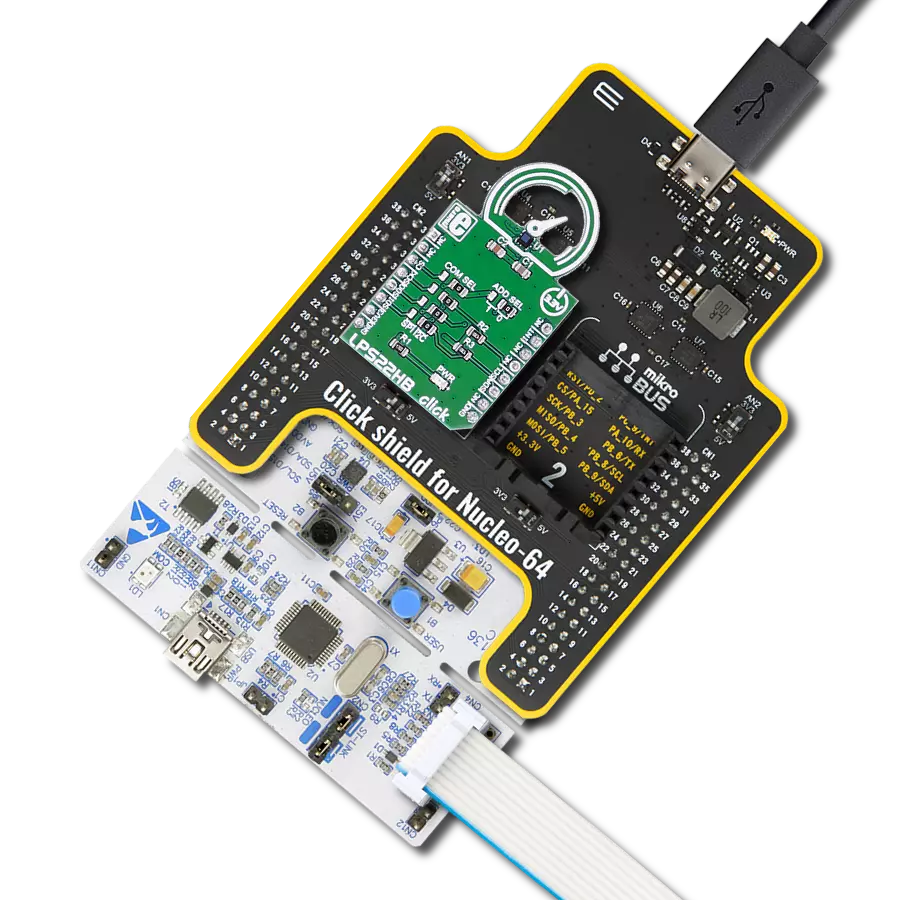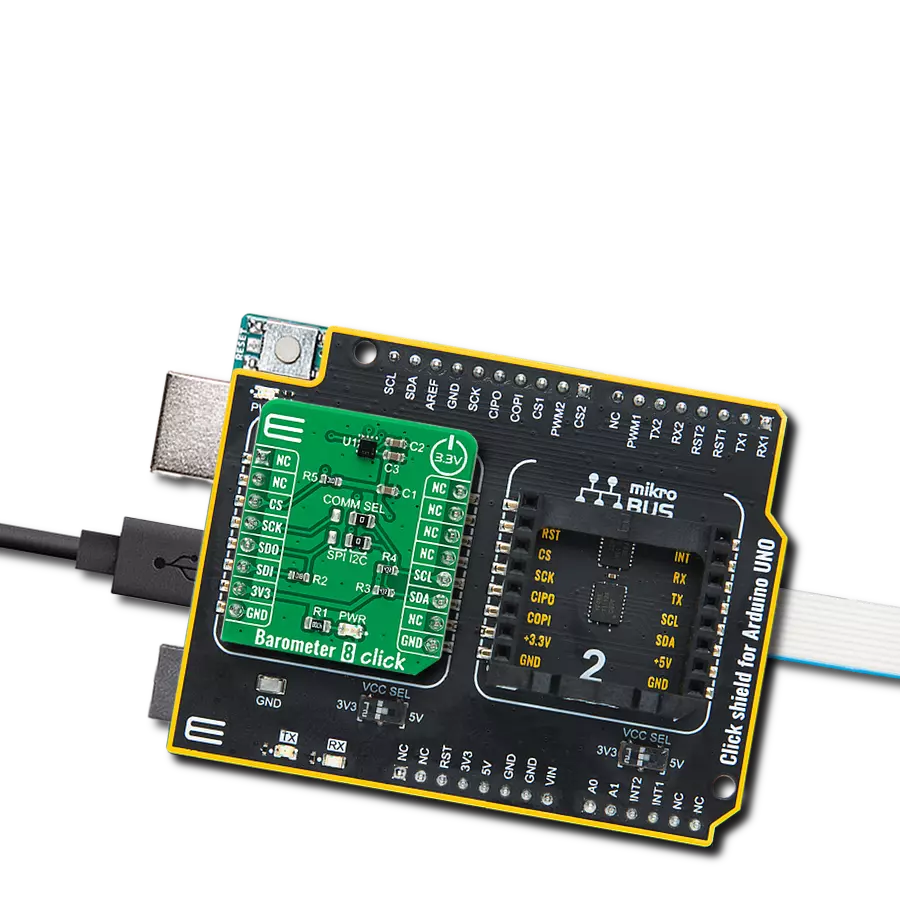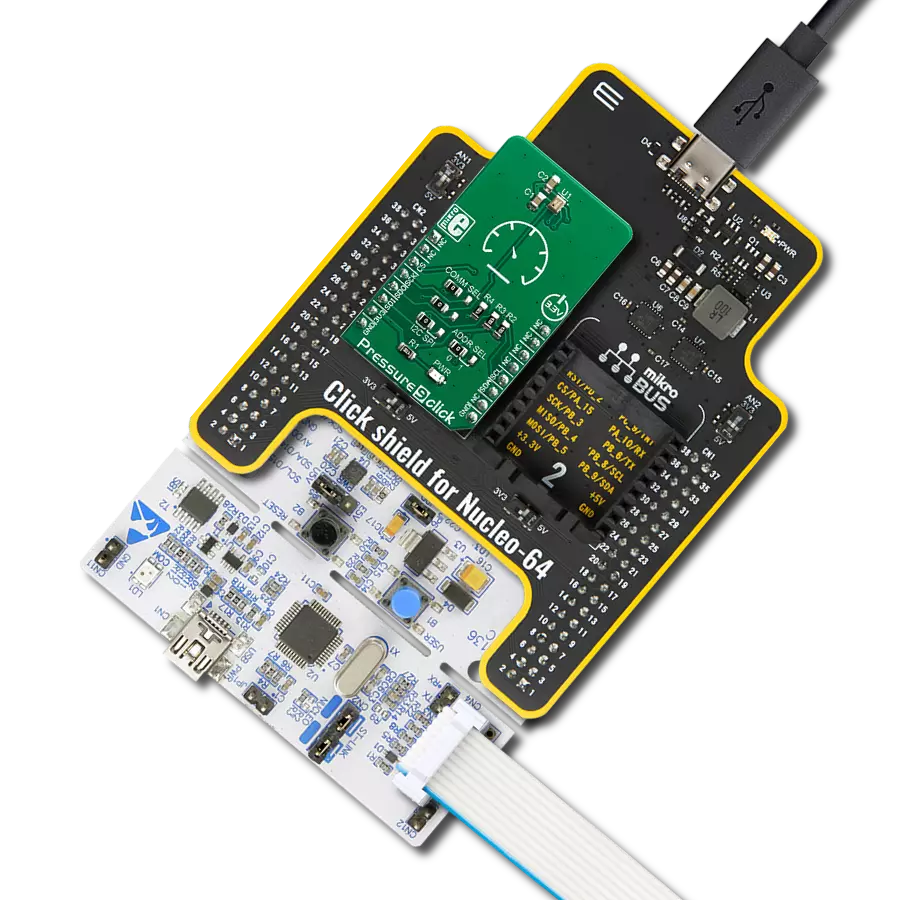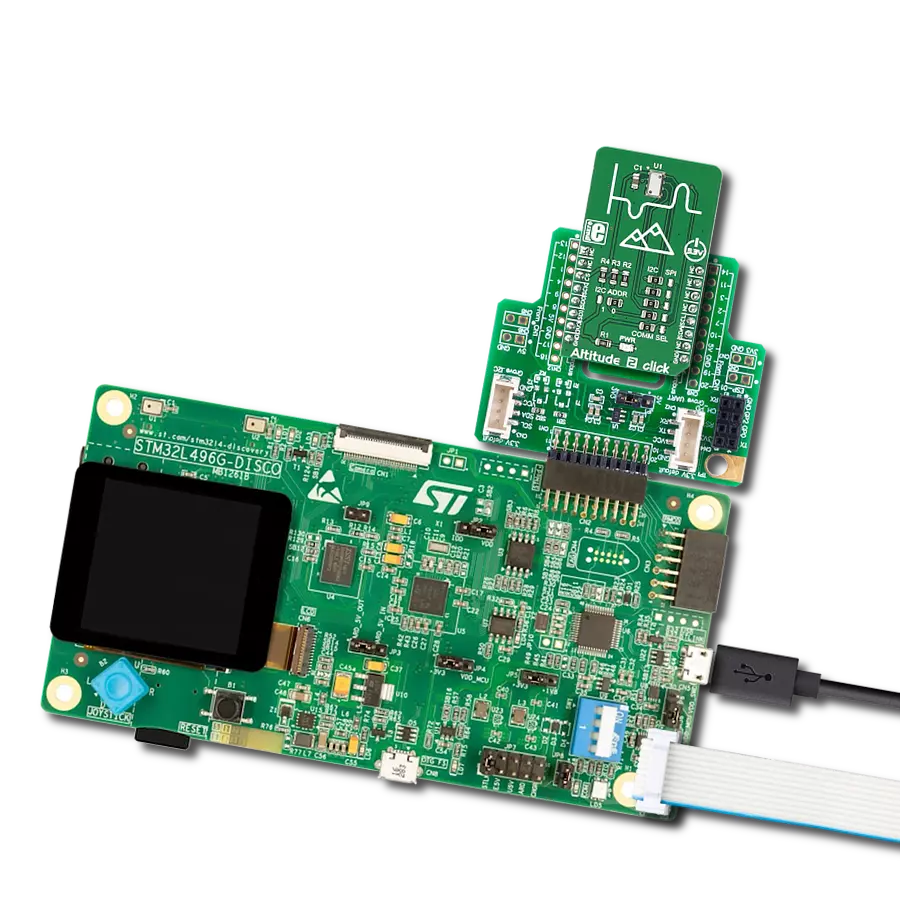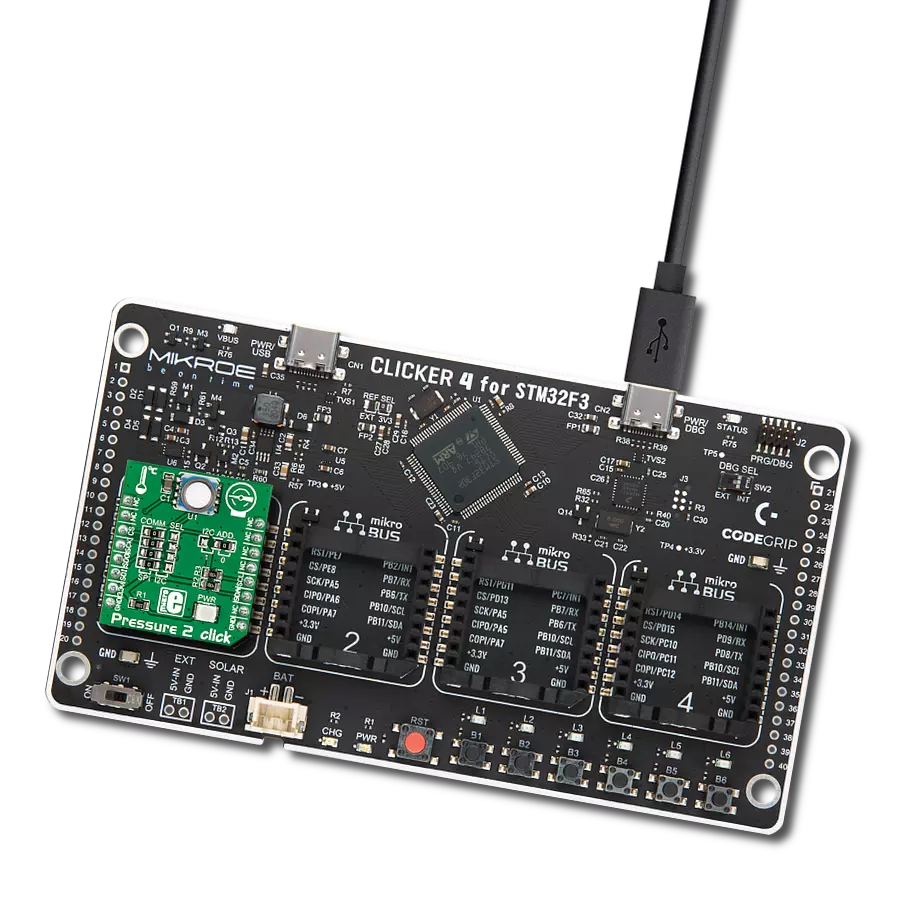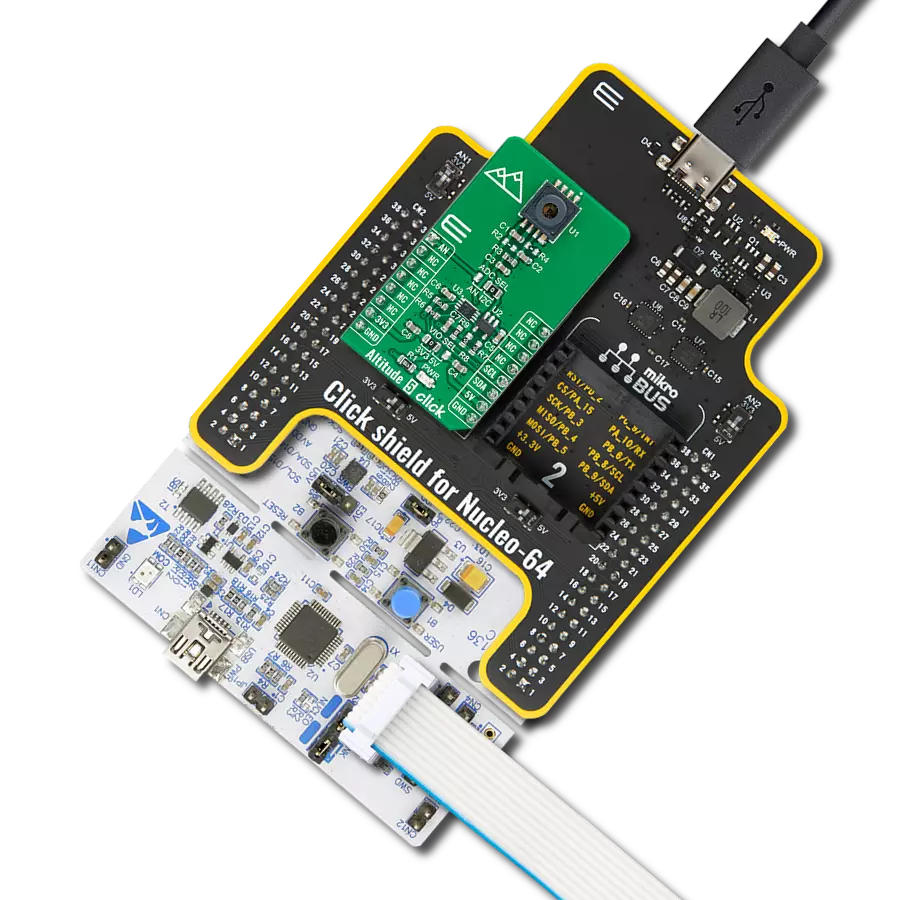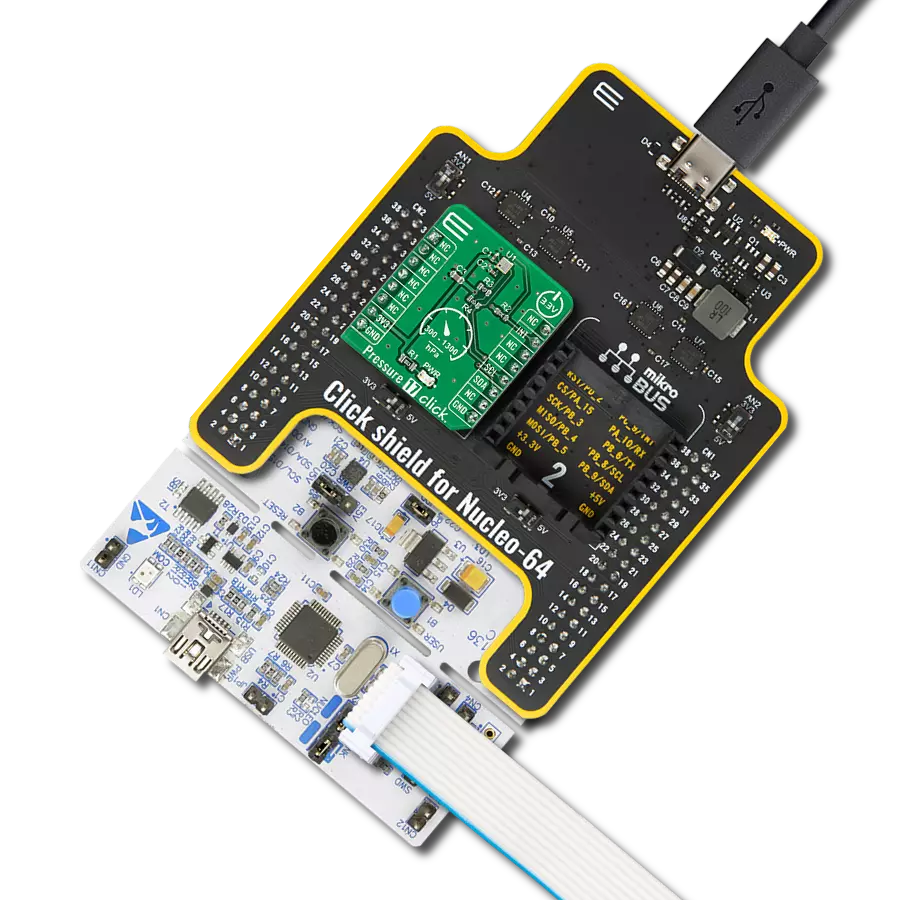Measure pressure accurately, with a typical relative accuracy of ±0.1mbar and an absolute accuracy of ±2mbar, even when subjected to high pressures
A
A
Hardware Overview
How does it work?
Pressure Click is based on the LPS331AP, a high accuracy, low-power 24-bit absolute barometric pressure sensor from STMicroelectronics. The LPS331AP provides a typical relative accuracy over pressure of ±0.1mbar and absolute accuracy of ±2mbar with high overpressure capability. It measures absolute pressure from 260mbar to 1260mbar over a wide operating temperature range. The complete device includes a sensing element based on a piezoresistive Wheatstone bridge and an interface that takes the information from the sensing element to the host MCU as a digital signal. The sensing element consists of a suspended membrane realized inside a single mono-silicon substrate capable of detecting
pressure, manufactured using a dedicated process developed by ST called VENSENS. This process allows building of a mono-silicon membrane above an air cavity with a controlled gap and defined pressure. On the other hand, the LPS331AP's interface is manufactured using a standard CMOS process and factory calibrated at three temperatures and two pressures for sensitivity and accuracy. Pressure Click allows using both I2C and SPI interfaces. The selection can be made by positioning SMD jumpers labeled as COMM SEL in an appropriate position. Note that all the jumpers' positions must be on the same side, or the Click board™ may become unresponsive. While the I2C interface is selected, the LPS331AP allows
choosing the least significant bit (LSB) of its I2C slave address using the SMD jumper labeled I2C ADD. This Click board™ also possesses an additional interrupt pin, routed to the INT pin on the mikroBUS™ socket, indicating when a specific pressure event occurs. This Click board™ can only be operated with a 3.3V logic voltage level. The board must perform appropriate logic voltage level conversion before using MCUs with different logic levels. Also, this Click board™ comes equipped with a library containing easy-to-use functions and an example code that can be used as a reference for further development.
Features overview
Development board
PIC32MZ Clicker is a compact starter development board that brings the flexibility of add-on Click boards™ to your favorite microcontroller, making it a perfect starter kit for implementing your ideas. It comes with an onboard 32-bit PIC32MZ microcontroller with FPU from Microchip, a USB connector, LED indicators, buttons, a mikroProg connector, and a header for interfacing with external electronics. Thanks to its compact design with clear and easy-recognizable silkscreen markings, it provides a fluid and immersive working experience, allowing access anywhere and under
any circumstances. Each part of the PIC32MZ Clicker development kit contains the components necessary for the most efficient operation of the same board. In addition to the possibility of choosing the PIC32MZ Clicker programming method, using USB HID mikroBootloader, or through an external mikroProg connector for PIC, dsPIC, or PIC32 programmer, the Clicker board also includes a clean and regulated power supply module for the development kit. The USB Micro-B connection can provide up to 500mA of current, which is more than enough to operate all onboard
and additional modules. All communication methods that mikroBUS™ itself supports are on this board, including the well-established mikroBUS™ socket, reset button, and several buttons and LED indicators. PIC32MZ Clicker is an integral part of the Mikroe ecosystem, allowing you to create a new application in minutes. Natively supported by Mikroe software tools, it covers many aspects of prototyping thanks to a considerable number of different Click boards™ (over a thousand boards), the number of which is growing every day.
Microcontroller Overview
MCU Card / MCU
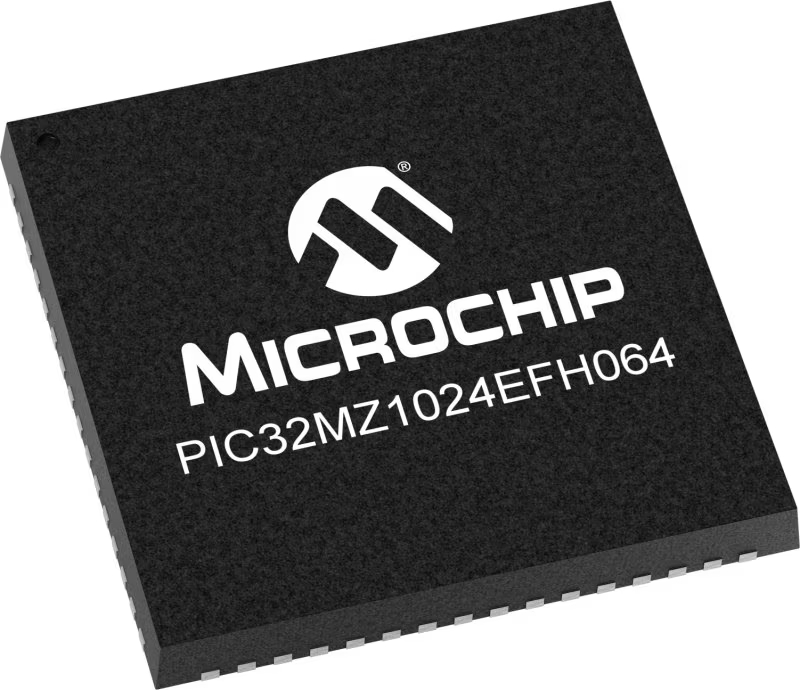
Architecture
PIC32
MCU Memory (KB)
1024
Silicon Vendor
Microchip
Pin count
64
RAM (Bytes)
524288
Used MCU Pins
mikroBUS™ mapper
Take a closer look
Click board™ Schematic

Step by step
Project assembly
Track your results in real time
Application Output
1. Application Output - In Debug mode, the 'Application Output' window enables real-time data monitoring, offering direct insight into execution results. Ensure proper data display by configuring the environment correctly using the provided tutorial.

2. UART Terminal - Use the UART Terminal to monitor data transmission via a USB to UART converter, allowing direct communication between the Click board™ and your development system. Configure the baud rate and other serial settings according to your project's requirements to ensure proper functionality. For step-by-step setup instructions, refer to the provided tutorial.

3. Plot Output - The Plot feature offers a powerful way to visualize real-time sensor data, enabling trend analysis, debugging, and comparison of multiple data points. To set it up correctly, follow the provided tutorial, which includes a step-by-step example of using the Plot feature to display Click board™ readings. To use the Plot feature in your code, use the function: plot(*insert_graph_name*, variable_name);. This is a general format, and it is up to the user to replace 'insert_graph_name' with the actual graph name and 'variable_name' with the parameter to be displayed.

Software Support
Library Description
This library contains API for Pressure Click driver.
Key functions:
pressure_generic_single_write- Generic Single Write functionpressure_generic_multiple_read- Generic Multiple Read functionpressure_get_pressure- Pressure Get function
Open Source
Code example
The complete application code and a ready-to-use project are available through the NECTO Studio Package Manager for direct installation in the NECTO Studio. The application code can also be found on the MIKROE GitHub account.
/*!
* \file main.c
* \brief Pressure Click example
*
* # Description
* This is a example which demonstrates the use of Pressure Click board.
* Measured pressure and temperature data from the LPS331AP sensor on Pressure
* Click.
*
* The demo application is composed of two sections :
*
* ## Application Init
* Initializes I2C/SPI serial interface and puts a device to the initial state.
* Also initializes UART console module for results logging.
*
* ## Application Task
* Reads the pressure and temperature results in standard units when
* measurement was done and sends results to the console (usb uart terminal).
* Repeats operation every 500ms.
*
* \author Nemanja Medakovic
*
*/
// ------------------------------------------------------------------- INCLUDES
#include "board.h"
#include "log.h"
#include "pressure.h"
// ------------------------------------------------------------------ VARIABLES
static pressure_t pressure;
static log_t console;
static const uint8_t deg_cels[ 3 ] = { 176, 'C', 0 };
// ------------------------------------------------------ APPLICATION FUNCTIONS
void application_init( void )
{
pressure_cfg_t pressure_cfg;
log_cfg_t console_cfg;
/**
* Logger initialization.
* Default baud rate: 115200
* Default log level: LOG_LEVEL_DEBUG
* @note If USB_UART_RX and USB_UART_TX
* are defined as HAL_PIN_NC, you will
* need to define them manually for log to work.
* See @b LOG_MAP_USB_UART macro definition for detailed explanation.
*/
LOG_MAP_USB_UART( console_cfg );
log_init( &console, &console_cfg );
log_info( &console, "---- Application Init ----" );
// Click initialization.
pressure_cfg_setup( &pressure_cfg );
PRESSURE_MAP_MIKROBUS( pressure_cfg, MIKROBUS_1 );
pressure_init( &pressure, &pressure_cfg );
pressure_sw_reset( &pressure );
pressure_default_cfg( &pressure );
}
void application_task( void )
{
uint8_t status;
float press;
float temp;
status = pressure_get_status( &pressure, PRESSURE_FLAG_MASK_P_DATA_RDY |
PRESSURE_FLAG_MASK_T_DATA_RDY );
while ( !status )
{
status = pressure_get_status( &pressure, PRESSURE_FLAG_MASK_P_DATA_RDY |
PRESSURE_FLAG_MASK_T_DATA_RDY );
}
press = pressure_get_pressure( &pressure );
temp = pressure_get_temperature( &pressure );
log_printf( &console, "** Pressure is %.2f mbar\r\n", press );
log_printf( &console, "** Temperature is %.2f ", temp );
log_printf( &console, "%s\r\n", deg_cels );
log_printf( &console, "**************************************\r\n" );
Delay_ms ( 500 );
}
int main ( void )
{
/* Do not remove this line or clock might not be set correctly. */
#ifdef PREINIT_SUPPORTED
preinit();
#endif
application_init( );
for ( ; ; )
{
application_task( );
}
return 0;
}
// ------------------------------------------------------------------------ END

















